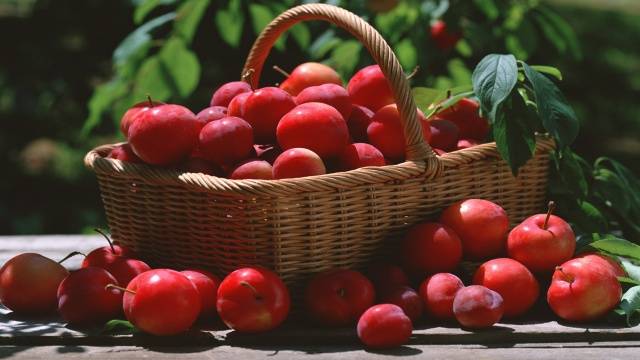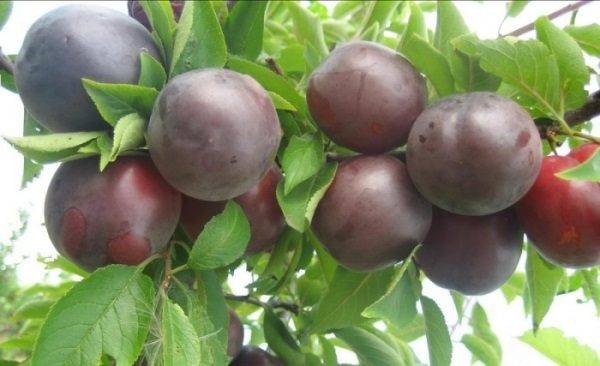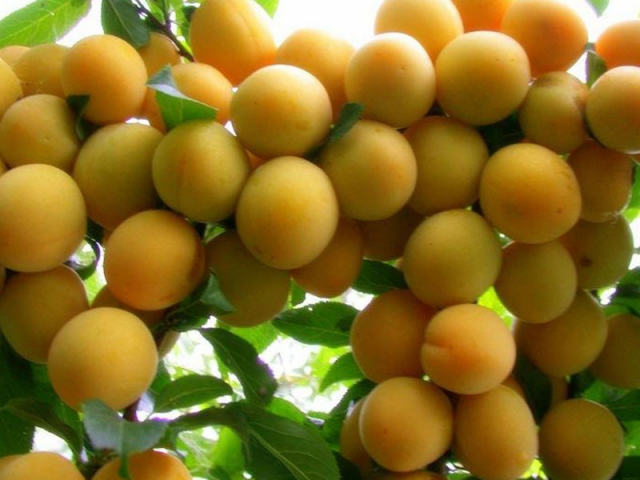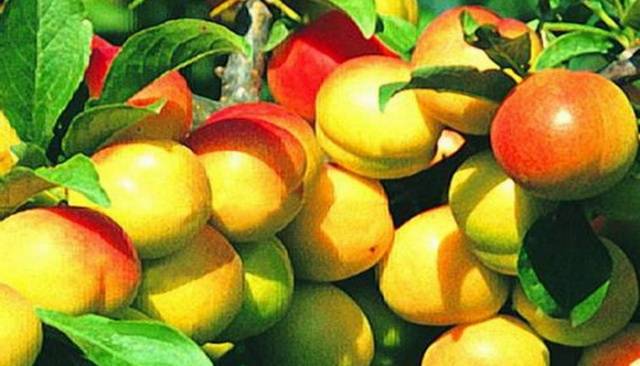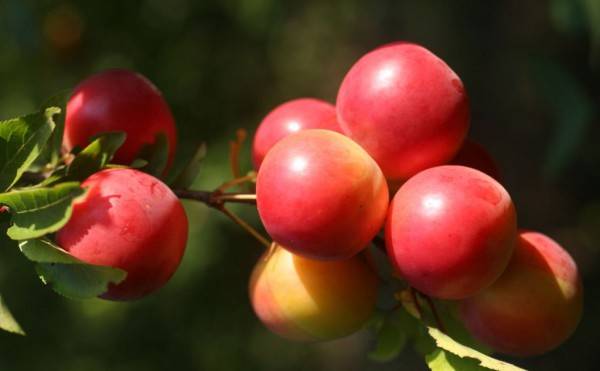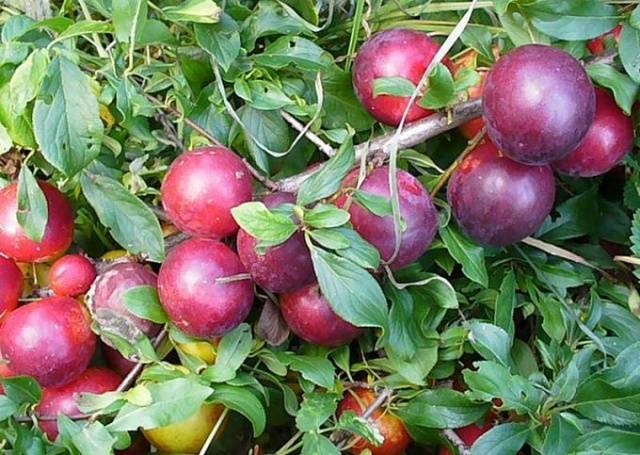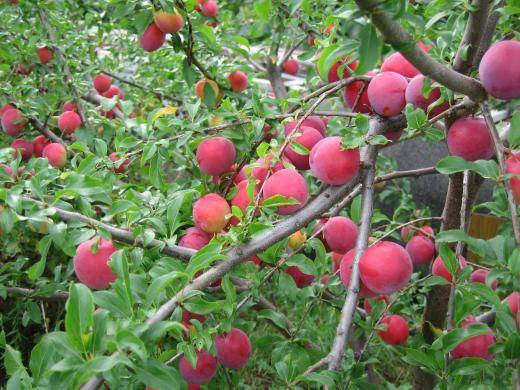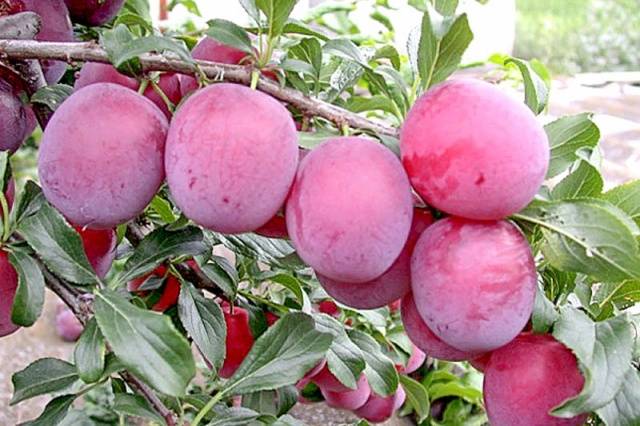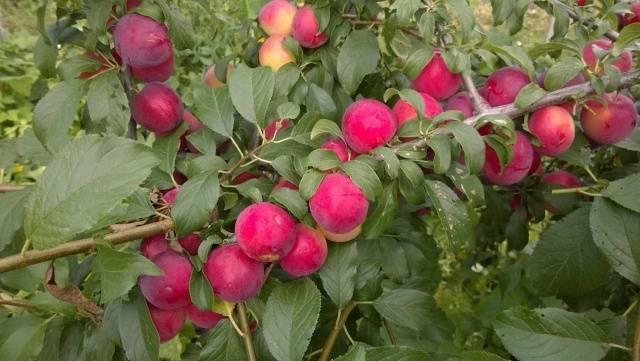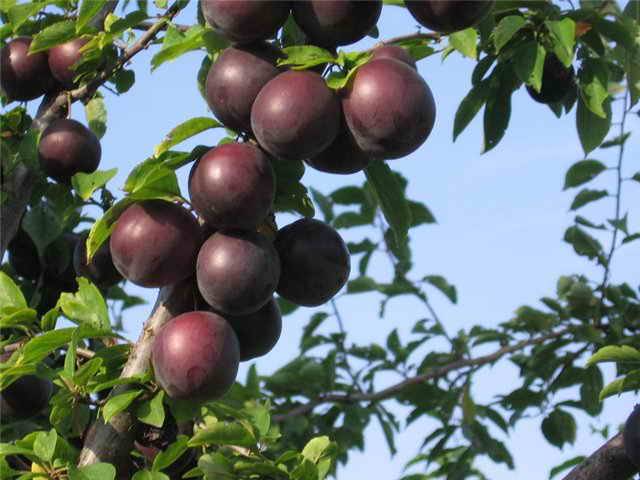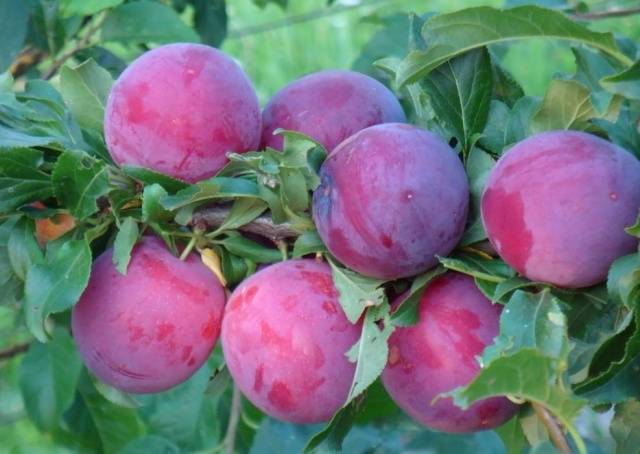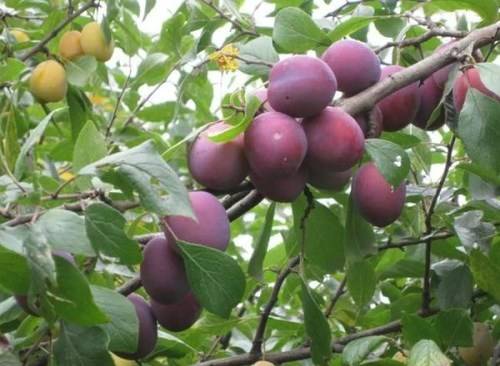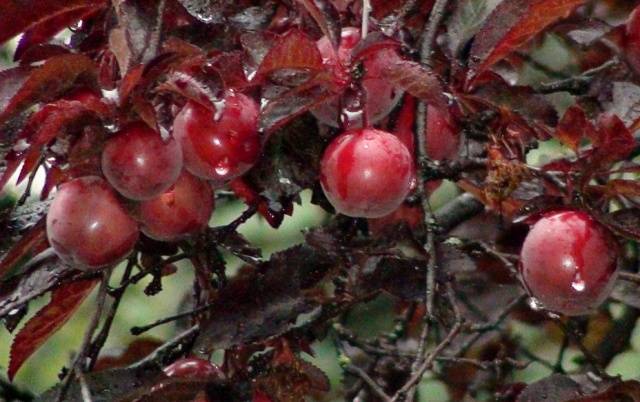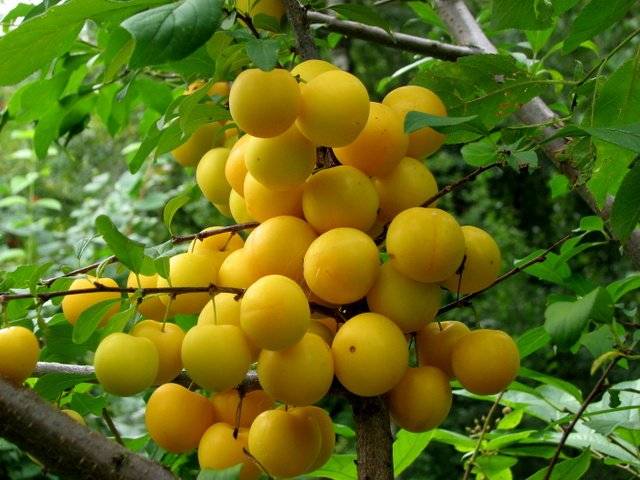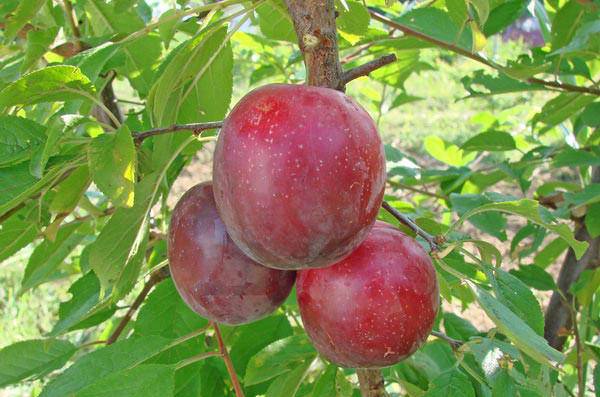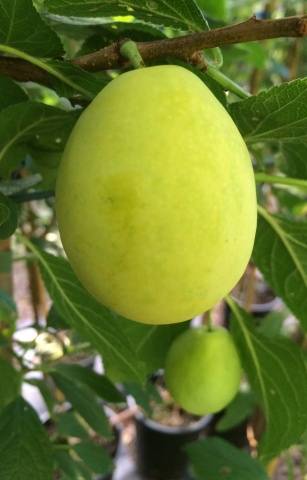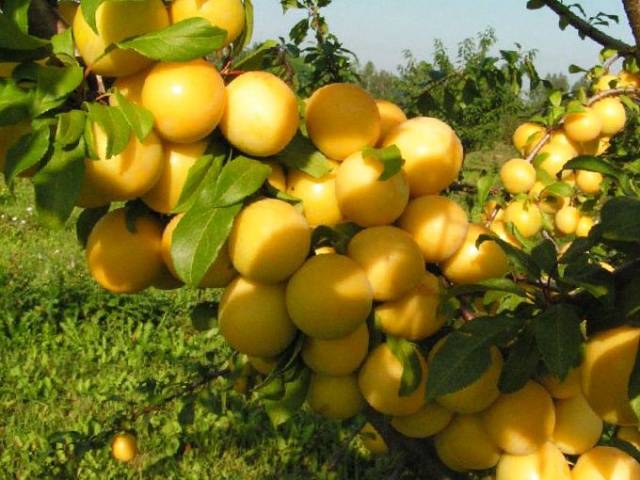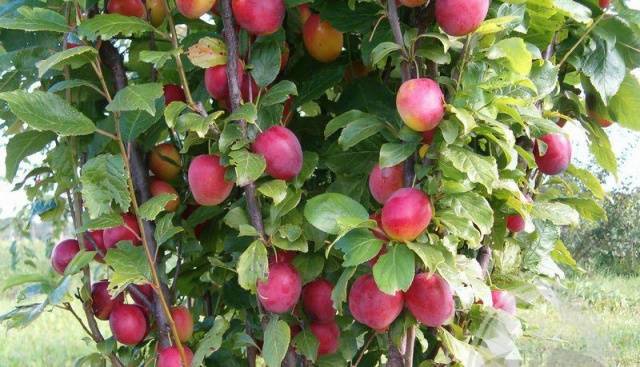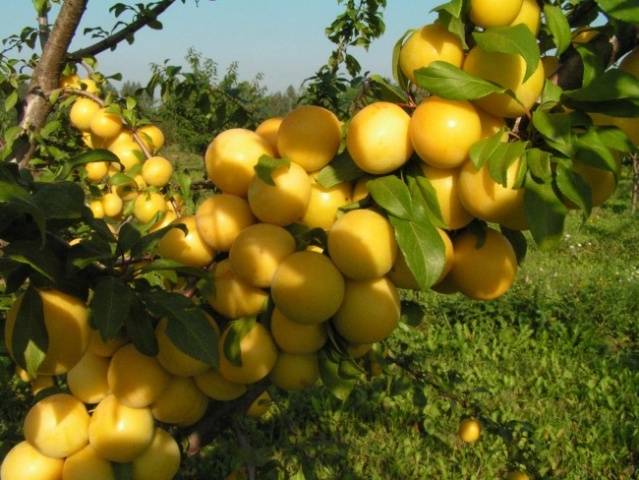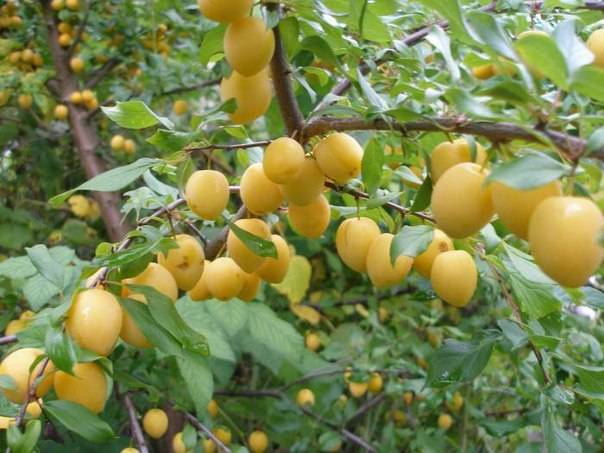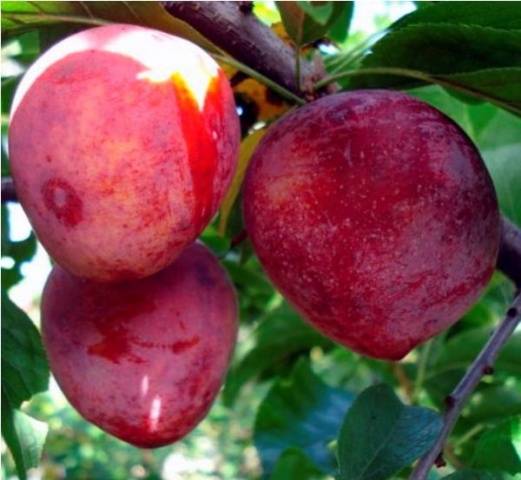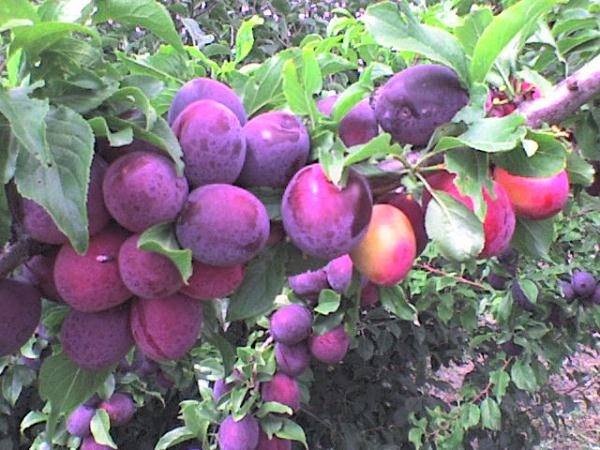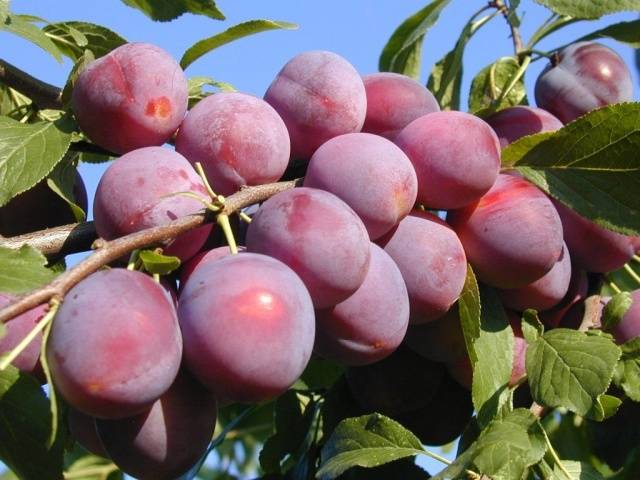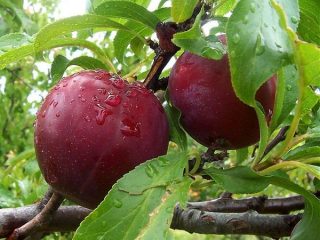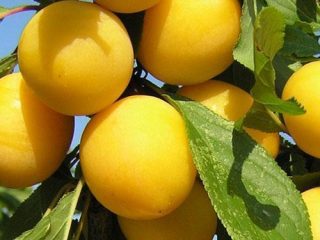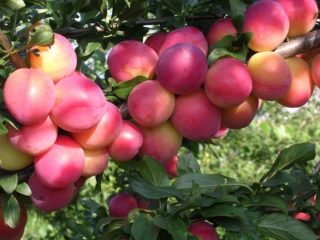Content
- 1 Review of common cherry plum varieties
- 2 The best varieties of cherry plum
- 3 Classification of cherry plum varieties by ripening time
- 4 Large-fruited cherry plum
- 5 Self-fertile cherry plum varieties
- 6 Hybrid varieties of cherry plum
- 7 Varieties of red-leaved cherry plum
- 8 How are cherry plums classified by shade?
- 9 Taste characteristics of cherry plum varieties
- 10 What to consider when choosing seedlings
- 11 The best varieties of cherry plum for the Moscow region
- 12 The best varieties for the Leningrad region
- 13 The best varieties of cherry plum for the Urals
- 14 The best varieties of cherry plum for central Russia
The cherry plum varieties available to gardeners differ in their fruiting time, frost resistance and fruit characteristics. It is a low tree or shrub. Thanks to selection, it can bear fruit abundantly even in the northern regions. Some varieties have early ripening periods, so the harvest can be harvested before the onset of autumn frosts.
Review of common cherry plum varieties
If you want to plant cherry plum on your plot, the gardener needs to familiarize yourself with the characteristics of the varieties. They are divided into groups depending on ripening time, tree size, fruit characteristics and other parameters.
According to the ripening period, early-ripening, mid-ripening and late-ripening varieties are presented. Brief information about them is collected in the table below.
Early ripening | Mid-season | Late ripening |
Zlato Scythians (Zlata Scythians). Gives an average harvest, golden fruits weighing up to 40 g. | Cleopatra. A medium-yielding species with large fruits reaching 50 g. The color of ripe cherry plum is dark purple, the flesh is red. | Gold autumn. The fruits are small, weighing 10 g. The advantage is that the harvest is stored on the branches until late autumn. |
Traveler. Brings up to 40 kg of harvest per season, fruit weight up to 30 g, yellow color. | Kuban comet. Produces up to 40 kg of fruit. Fruits weighing up to 30 g, yellow skin color. | Moscow Hungarian. Brings 20 kg of fruit weighing 25 g. The color is red. |
Found. It begins to bear fruit in the third year, the weight of the yellow fruit reaches 37 g. | Huck. Yellow fruits weighing up to 45 g. The tree is capable of self-pollination. |
|
Ruby. The fruits have dark red skin and orange flesh. | Morning. The tree is not tall. The weight of the fruit reaches 35 grams, the color is yellow. |
|
Also, types of cherry plum differ in the size of the fruit. Their weight can range from 10 to 50 g. Gardeners have access to trees with yellow, red and dark purple fruits.
When choosing seedlings, you need to pay attention to yield. High-yielding varieties produce about 40 kg of fruit per year.
It is important to consider the climate zone where the planting will take place. For Siberia and the middle zone, it is recommended to choose species with high winter hardiness. You can take a variety with average winter hardiness. If the temperature drops significantly, the bush may be damaged, but subsequently it is easily restored.
The best varieties of cherry plum
Some types of cherry plum are especially popular among gardeners.They are resistant to low temperatures and drought, and also produce abundant harvests.
Let's consider several large-fruited varieties:
- Tent. The tree is low, with a dense rounded crown. Brings large fruits weighing up to 40 g. The skin has a dark purple hue, the flesh is yellow with a sweet and sour taste. Fruiting begins 4–5 years after planting; a harvest of 35 kg can be obtained per season. Refers to early-fruiting crops. It is characterized by high frost resistance and average resistance to drought.
- Huck. Refers to mid-season varieties. The tree is not tall and reaches its maximum size in a short time. The weight of one yellow fruit is up to 35 g. It produces a bountiful harvest and is resistant to low temperatures.
- Precocious. A compact shrub, fruiting begins already at 2–3 years of age. The fruit is medium-sized, yellow-red skin. The pulp is very pleasant to the taste, easily comes off the seed, and is therefore suitable for direct consumption. Resistance to low temperatures and winds.
Listed above are the types of cherry plum that are loved by many gardeners. They are frost-resistant, so they can be grown successfully in regions with cold winters.
Classification of cherry plum varieties by ripening time
Cherry plum varieties do not have a strict classification. However, depending on the ripening period, they are divided into early, middle and late. The first ones produce a harvest already in July–August. The ripening period for mid-season fruits is the end of August. The later ones are filmed in September.
Early ripening
Nesmeyana - one of the early ripening varieties. The height of the tree can reach 6 meters; the harvest lasts for 3–4 years. Ripening begins in July. Characterized by red skin and round shape. The weight of one piece reaches 30 g.A self-sterile variety; Cleopatra, Kuban Comet, and Traveler can act as pollinators.
Sigma. A low tree that produces abundant harvests. Refers to self-sterile species. Fruits with yellow skin weighing up to 35 g, the pulp is difficult to separate from the stone.
Mid-season
Chuk. Reaches a height of 3–4 m, produces about 30 kg of harvest per year. Fruit of a dark purple hue, weighing 30 g. It is characterized by average resistance to low temperatures. Self-sterile, Chinese plum or other cherry plum is suitable as a pollinator. Produces a stable harvest and resists diseases.
Peach. It has sweet flesh and red-burgundy skin. The taste is reminiscent of peach, which is reflected in the name.
Late ripening
Moscow Hungarian. Tree of medium height, self-fertile. The fruits ripen, weighing 25 g, juicy, with red skin. Average resistance to frost.
Cleopatra. Medium-sized tree with high yield. It bears fruits of a dark purple hue weighing up to 37 g with tasty red pulp. Refers to self-sterile species.
Large-fruited cherry plum
One of the largest-fruited cherry plum species is General. The weight of the fruit can reach 80 g; they are located separately on the branches. The variety is resistant to frost and is considered early ripening.
globe - a large-fruited variety, the weight of one piece can reach 100 g. This is a hybrid obtained by crossing the Obilnaya variety, the Kulturnaya Red hybrid and the apricot. If the harvest is abundant, the fruits are smaller in size, but still reach a weight of 50–60 g. The color of the skin is dark blue, the flesh is yellow, and juicy. Due to intensive growth, branches should be pruned regularly.
Self-fertile cherry plum varieties
Kuban comet. One of the self-fertile species that does not require planting a pollinator nearby. The fruits have a relatively small weight - up to 28 g. The skin is reddish in color, the flesh is yellow with a sweet and sour taste. The tree is not very tall and produces up to 40 kg of harvest per year. Needs regular watering.
Mara. Another self-fertile variety that is highly resistant to frost and disease. The height of the tree is 2–3 m and forms a spherical crown. Bears rich yellow fruits. Ripening occurs at the beginning of July, and the harvest does not fall until the first days of August. The pulp tastes very sweet.
Hybrid varieties of cherry plum
Abundant. This hybrid was bred in 1969 and is suitable for cultivation in the North Caucasus region. The fruits have a pleasant taste and aroma, weighing 30 g or more. The skin is dark purple. It bears abundant fruit.
Dessert. Obtained as a result of crossing a Chinese plum and a variety called Tavricheskaya. The tree is of medium height, forms a drooping crown. The fruits grow weighing 30–35 g, the skin is dark red in color. The pulp is dense, orange. Characterized by low resistance to frost.
Varieties of red-leaved cherry plum
Lama will not only bring a bountiful harvest (40–50 kg per tree), but will also become a decoration of the garden. The fruits have a sweet and sour taste, their weight varies between 30–40 g. A low-growing shrub no more than 2 m in height. Lama's peculiarity is its reddish leaves. Ripe fruits fall off easily in strong winds. It can be grown in the middle zone, the North-West region and Siberia.
How are cherry plums classified by shade?
Another characteristic by which cherry plum varieties are classified is the color of the fruit. It can vary from yellow to dark purple and almost black.
Yellow cherry plum
Tsarskaya. It bears small yellow fruits weighing up to 20 g. They ripen by the beginning of August and are valued for their excellent taste and portability. Rich in citric acid, contain a lot of sugar. The tree is medium-sized and begins to bear fruit already in the second year after planting.
Oriole. It grows to a height of just over 5 m and bears fruit regularly and abundantly. It is resistant to heat and lack of moisture. Yellow color. Ripens at the end of July.
Cherry plum with red fruits
July rose bears red, elongated fruits, weighing up to 40 g. The tree is of medium height. It can bear fruit without a pollinator, but with one present it will produce a larger harvest.
Green cherry plum
Unripe cherry plum is used in cooking as part of sauces and side dishes. Green fruits contain large amounts of citric acid. By adding this seasoning to a dish, you can improve both its taste and digestibility.
Cherry plum with purple fruits
Found. Large-fruited variety with early ripening. Fruiting begins already in the 3rd year of life, the weight of the crop can reach 40 kg per year. The fruit is purple in color with yellow flesh, weighing up to 35 g. Resistance to temperature changes is high, resistance to lack of moisture is average. For pollination, other species that bloom around the same time must be planted nearby.
Taste characteristics of cherry plum varieties
The variety of flavors was made possible by crossing cherry plums with certain types of plums. As a result, hybrids appeared that differed in other characteristics: color, ripening time, growing regions.
Sweet varieties of cherry plum
Apricot. Quite large fruits resemble apricots. The skin is yellow-pink. The pulp is yellow-orange, juicy, and sweet in taste.Ripening occurs during August. It can withstand frosts, but as a result of sharp temperature fluctuations the yield decreases.
Sweet and sour cherry plum
Sonya. A short tree, reaches 3 m. It bears yellow fruits with a sweet and sour taste, weighing between 40–50 g. The harvest ripens by the beginning of September. It is a fast-growing variety; fruiting begins 2–3 years after planting. Resistance to frost allows it to be grown in the middle zone.
What to consider when choosing seedlings
To get a bountiful harvest every year, you should choose the right variety. In this case, the gardener will focus on the following points:
- Climatic zone. If planting is planned in the middle zone or in Siberia, you need to choose seedlings with good winter hardiness.
- Maturing period. When several trees with different fruiting periods are planted on a plot, you can provide yourself with a constant harvest for the entire season.
- Characteristics of the fetus. Here you should pay attention to size, color, taste. This information can be found in the description.
- Tree height. Selected in accordance with the characteristics of the site.
When the choice is made, you can go to the nursery. It is recommended to purchase 4-year-old seedlings grown in your home region, as they take root better after planting on the site.
The best varieties of cherry plum for the Moscow region
It is best to purchase seedlings from local nurseries. In the markets you can buy a southern variety, which is not suitable for the climate of the Moscow region.
Self-fertile cherry plum varieties for the Moscow region
Columnar. The tree has an unusual shape - the height reaches 3 m, while the crown diameter is no more than 1.5 m. The variety is winter-hardy: it quickly recovers after freezing. The fruit grows weighing up to 40 g. The skin is red, the flesh is juicy, with a pleasant taste.This variety is resistant to diseases and pests.
Sweet varieties of cherry plum for the Moscow region
Zlato Scythians (Zlata Scythians). A low tree (up to 3 m) with a crown in the form of a wide cone. Fruits are golden in color with delicate, very sweet pulp. The variety is resistant to sudden temperature fluctuations.
Ruby. The skin is burgundy, the flesh is dark yellow. Ripe fruits also do not have sourness. Does not suffer from sudden changes in temperature and does not require complex care.
The best varieties for the Leningrad region
A hybrid is suitable for the Leningrad region Gift to St. Petersburg. It bears small fruits weighing about 10 g. They are yellow in color with a sweet and sour-tasting pulp. It is a high-yielding species: from one tree you can get up to 60 kg of harvest per season.
The best varieties of cherry plum for the Urals
Rocket seedling. Most suitable for the Urals; with proper care, it tolerates frosts down to -35 ºС. Large fruits weighing about 30 g. The skin is red, the pulp tastes sweet and sour.
The best varieties of cherry plum for central Russia
Vladimir comet. Relatively young, but at the same time promising appearance. Produces large fruits with burgundy skin. The taste of the pulp is sweet and sour, orange in color. Ripening begins already in mid-July. Frost resistance.
Timiryazevskaya. The height of the tree is within 3 m, the crown is cone-shaped. Gives abundant harvests - up to 30 kg per season. The tree is not susceptible to freezing and fungal diseases.
Cherry plum varieties for your garden should be chosen taking into account their winter hardiness and ripening time. Even an amateur gardener can grow such a tree on the site. Due to the self-sterility of many species, it is recommended to purchase 3-4 seedlings of different varieties and familiarize yourself with simple tips for caring for the crop.
